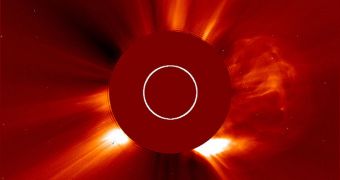A massive coronal mass ejection (CME) occurred from the right side of the Sun on July 23, solar physicists announce. The event saw a large volume of material being ejected from the solar surface at the highest speed ever detected by a dedicated observatory
The material the CME released flew past the one of the twin NASA Solar TErrestrial RElations Observatory (STEREO) spacecraft at a speed between 1,800 and 2,200 miles (2,897 to 3,540 kilometers) per second.
The STEREO mission is made up of two individual spacecraft, which orbit on opposite sides of the Sun. In this flight configuration, they provide a nearly-complete, 360-degree view of the entire solar surface, with minimal blind spots.
Since the vehicles launched, in 2006, no CME was recorded as flying at this tremendous speed. Experts believe that the underlying mechanisms which caused it must have been amplified by the fact that the Sun is nearing a peak in its activity, known as a solar maximum.
The star operates in 11-year cycles, alternating periods of high activity (known as maximums) with times of relatively low activity, called minimums. The maximum in the current solar cycle will be reached next year, and this CME is a symptom of that.
Using STEREO, the Solar Dynamics Observatory (SDO), and other similar satellites, experts can now keep track of how coronal mass ejections and solar flares occur, and how they influence the environment around the Sun.
“Between 1,800 and 2,200 miles per second puts it without question as one of the top five CMEs ever measured by any spacecraft. And if it's at the top of that velocity range it's probably the fastest,” says Alex Young, a solar scientist at the NASA Goddard Space Flight Center (GSFC), in Maryland.
The July 23 CME was also observed by the Solar Heliospheric Observatory (SOHO), a mission operated jointly by NASA and the European Space Agency (ESA). The added measurements helped confirm the speed that STEREO-A originally established.
“Seeing a CME this fast, really is so unusual. And now we have this great chance to study this powerful space weather, to better understand what causes these great explosions, and to improve our models to incorporate what happens during events as rare as these,” Evans explains.
The active region of the Sun where the superfast CME originated is called AR 1520. NASA scientists say it produced four Earth-bound ejections over the last three weeks, which is why several solar observatories were looking at it when the latest event occurred.

 14 DAY TRIAL //
14 DAY TRIAL //